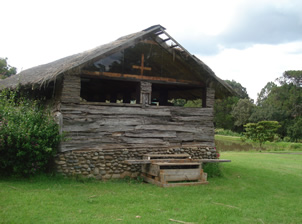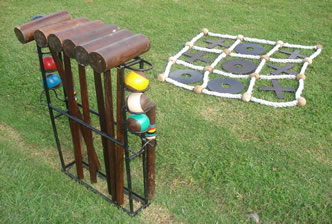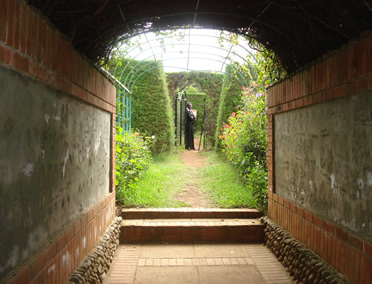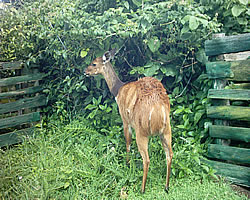|
Country Info
....................................................................................................................................
The Central
Highlands

Mount Kenya
This region may be viewed in different
perspectives. There is something for the adventurer, for the relaxed
tourist, and the business traveller. Birdwatchers and mountain
climbers will especially enjoy themselves!
The Journey
From Nairobi journey along Thika road, and across
the Tana River Sagana bridge. The road is relatively smooth. Mount
Kenya becomes visible just before arriving at Kibingoti market, a
good stopover to buy fresh produce.
The next stretch of potholed road leads through a
slopy landscape to a T-junction. Turn right here- many signboards
give clear directions to the lodges and parks- and on to Naro Moru.
Further down the road, just before Nanyuki town and 60km after Nyeri
town is a murram road turn-off that leads to the Mount Kenya
National Park. Private transport or use of touring companies is
advisable because public transport does not come this far.
You will be expected to pay a reasonable park fee
to enter the park, that goes towards the preservation of the park's
flora and fauna, a delightful observation also contained within the
grounds of the Safari club that is conveniently located in the
depths of the park.
Accommodation
Fairmont hotel's Mt. Kenya Safari club has quite a
story to it: three safari companions- a Texas oil millionaire, an
international film star and a Swiss financier grew the bejeweled
club out of a small country hotel in 1959. So for those of you who
are as just as fascinated by heritage and history as I am, treat
yourselves to a display of the artifacts collected over decades by
both the owners and guests of the club. From elephant tusks to
wooden carvings, as well as numerous photos that tell the club's
story; it was used as a base for film casts and crews of innumerable
movies such as King Solomon's Mines and Mogambo,
and has been the chosen holiday venue for American and European film
stars.
This club was in early 2005 listed in the
prestigious Travel and Leisure magazine's top 500 hotels in the
world, topping the ‘best upcountry hotel' category. Its grounds also
house a 24-hour heated swimming pool, nine-hole golf course and by
no means least, a wedding chapel and grounds perfect for that one
special ceremony.
 Wedding chapel Wedding chapel
William Holden, one of the founders, designed this
cottage that was his residence until his death in 1981. 12 more
cottages were fashioned in the same way, and from a bird's eye view
it looks like a plush residential estate. The inside is comfortably
furnished with a fireplace that is lit every evening before you go
to sleep.
Two other types of accommodation are available.
There are the more popular riverside suites, and in the main hotel
building are more rooms and suites which can house up to 250 guests
in total.
Daytime activities
The club's slogan reads ‘Welcome to our world'. And
what a world!
It offers a fantastic view of Mt. Kenya- actually
the word to describe it is breathtaking, and you can get a closer
look at its peaks through a giant pair of binoculars that have been
used for decades for just that purpose. This is my second visit to
the Mt. Kenya region but this time round I'm even more impressed.
The American actress Stefanie Powers once stayed here and had this
to say about the fauna around Kenya 's highest mountain:
“In life some things must be experienced rather
than described; such as the evening's view across the luxurious
gardens and natural forests leading to the imposing peak of
‘Kirinyaga', as Mt. Kenya is called in the Kikuyu language”.
Mt. Kenya is thought to be the shyest mountain in
Kenya because it hides its peaks most of the day, revealing them
briefly only at sunrise and sunset. So we were fortunate to have
such a clear view of its peaks vividly etched against the blue sky.
Currently the lawns are parched since February
isn't the rainy season, though I'm told that when the grass is
green, its lawns sit like one large, well-manicured golf course.
Daytime temperatures are high, especially since the club sits
squarely on the equator. Nevertheless we still see plenty of
birdlife around watering pools into which the club pumps water to
sustain the different birds like turkeys, Crested Crane which is the
national bird of Uganda, Sacred Ibis which is the national bird of
Egypt, and the marabou stork. All in all there are 180 species of
birdlife present on the grounds of this club, so it's a great haven
for passionate birdwatchers!
Aside from birdwatching though, there are other
daytime activities that one could engage in.
Croquet
My new friend Leah from the hotel treats me to a
game of croquet on the hotel grounds. This is a game of British
origin, not very common in Kenya so I had to receive a crash course
from the instructor.
If you are into games that don't require much
physical effort then this is right up your alley. After picking a
light wooden mallet and ball in matching colours, prepare yourself
for a couple of hours of trying to knock your ball through white
rectangular pins spread out in a zigzag pattern across the pitch,
and if in the process you knock your competitors' ball out of the
way the better! This provides you with an extra shot, and you can
even pick your ball to position it suitably where it will cause the
most damage. Practice makes this friendly game perfect.
Croquet kit 
Millenium maze
If croquet is however not exactly your cup of tea,
then you could always take a walk through the Millenium maze.

Entrance to the millenium maze
with handprints on the cemented walls
The maze was built in 1999. During the opening
ceremony participants left their signatures and palm prints in wet
cement to mark the ushering in of the millennium. It's fun for both
kids and adults, who take anywhere between 10 minutes to 2 hours to
find their way through. But as Leah says, keep left, and if you get
lost this actually just adds to the excitement! If you are
absolutely unable to find your way out, then just whistle or wave a
white handkerchief above the Cyprus fence and someone will find you.
The challenge is in not knowing if you're going the right way!
Mount Kenya Game Ranch animal
orphanage
Next on our itinerary is a visit to the in-house
Mount Kenya Game Ranch animal orphanage where we find a member of
the camel family that is indigenous to South America- the llama.
Llamas were first brought into Kenya by an American
family for use in expeditions up Mt. Kenya. There are now 36 in
total, and they comfortably survive here because the climate is
similar to that in the Andes Mountains of South America . All the
animals here are either endangered, orphaned or were injured and
brought here to recover before release back into the wild. One
endangered species is the mountain bongo.
 Karen the bushbuck Karen the bushbuck
This is the world's most spectacular mountain
antelope. Over 100,000 Kenyan students have visited this orphanage
and had the opportunity to learn about and interact with this rare
mountain bongo, and the orphanage's hope is that these students will
one day be able to observe the bongo back in their ancestral home on
Mount Kenya. For 35 years they have been kept here under a breeding
programme aimed at increasing their numbers.
Close beside them graze some waterbuck, while I
though, am busy feeding Chucky the warthog who was brought here with
neurological problems. Warthogs are usually elusive in the wild so I
am glad to be able to feed and touch one; the fur feels like the
bristles of a hard brush.
Further along we encounter zebroids, and these are
the only two of their kind left in the world. It takes time to get
used to their seemingly odd appearance, what with their combination
of black Grevy's zebra stripes on a horse's brown body. They were
bred in the early 70's by a hunter who wanted the perfect
pack-animal.
Other animals present here include Peter the pygmy
hippo- pygmy because he is much smaller than the average sized
hippo; ostriches, and Karen the bushbuck. Primates bred here include
the black and white colobus monkeys that are endangered because of
their beautiful fur coats, which are still used by some tribes as
headdresses and garments. The African lynx or caracal is a member of
the cat family.
Finally Speedy Gonzalez, a giant tortoise, shows me
the way out of the orphanage as I sit astride his humongous shelled
back!
Nanyuki town
If however your explorative appetite hasn't been
completely whetted then you can visit the nearby Nanyuki town. Trips
to the town are optional and if you don't have your own transport,
then the touring company through which you organized your trip can
provide you with that. There isn't much to see in Nanyuki however.
It is a medium sized town northwest of Mt Kenya and is most common
as a meeting place for people trekking up the mountain, with plenty
of hotels, kiosks and other shops providing basic goods and
services.
Bush dinner
Regardless of whichever way you choose to spend
your day, the club will ensure that you have a superbly relaxed
evening to bring it to a close. A special bush dinner has been laid
out for the guests, while a gigantic bonfire drives away the chill
of the evening. Just before dinner is served Meru Chuka dancers
entertain us with their impressive drumming skills.
Nights in the Mt. Kenya region are chilly; so make
sure you include a jacket or heavy sweater in your luggage.
Breakfast
The next morning dawns bright and sunny as we head
to the dining area for breakfast. Ambience goes a long way in making
people comfortable. Breakfast is served in the club's dining area
that has an old Victorian feel to it with its maroon furnishings and
huge windows. This is a meeting point for many nationalities, all
brought together by one common need- a hearty breakfast to start the
day.
Equator ceremony
After breakfast we are directed to the club's
grounds for a special graduation ceremony, which is an activity
unique to the club. All guests participate in an equator ceremony
that demonstrates the coliolis force or effect, which is
caused by the rotation of the earth and resulting forces between the
north and south poles. The demonstration shows variations in the
behavior of water north and south of the equator as well as right on
the equator. Guests attentively watch as a bowl of water with a hole
at the bottom is used.
In the Northern hemisphere a stick placed on the
surface of the water rotates clockwise, while the spiral of water
draining through the hole is also clockwise. In the southern
hemisphere it's the reverse. The equator is 20meteres wide, and
while standing directly on it the stick will not move in any
direction, and the water drains straight down. After this
certificates are awarded to confirm we have successfully gone
through the ceremony.
The rest of the day is spent by the pool, strolling
some more through the gardens and going through historical journals
in the library. And finally at night, freshly lit fireplaces await
us in our very, cosy, rooms....
Accommodation rates and
images
Next: Mt.
Kenya - another angle.....
Related links:
Copyright 2007. All rights reserved. Exotic
Expeditions Limited. | 


